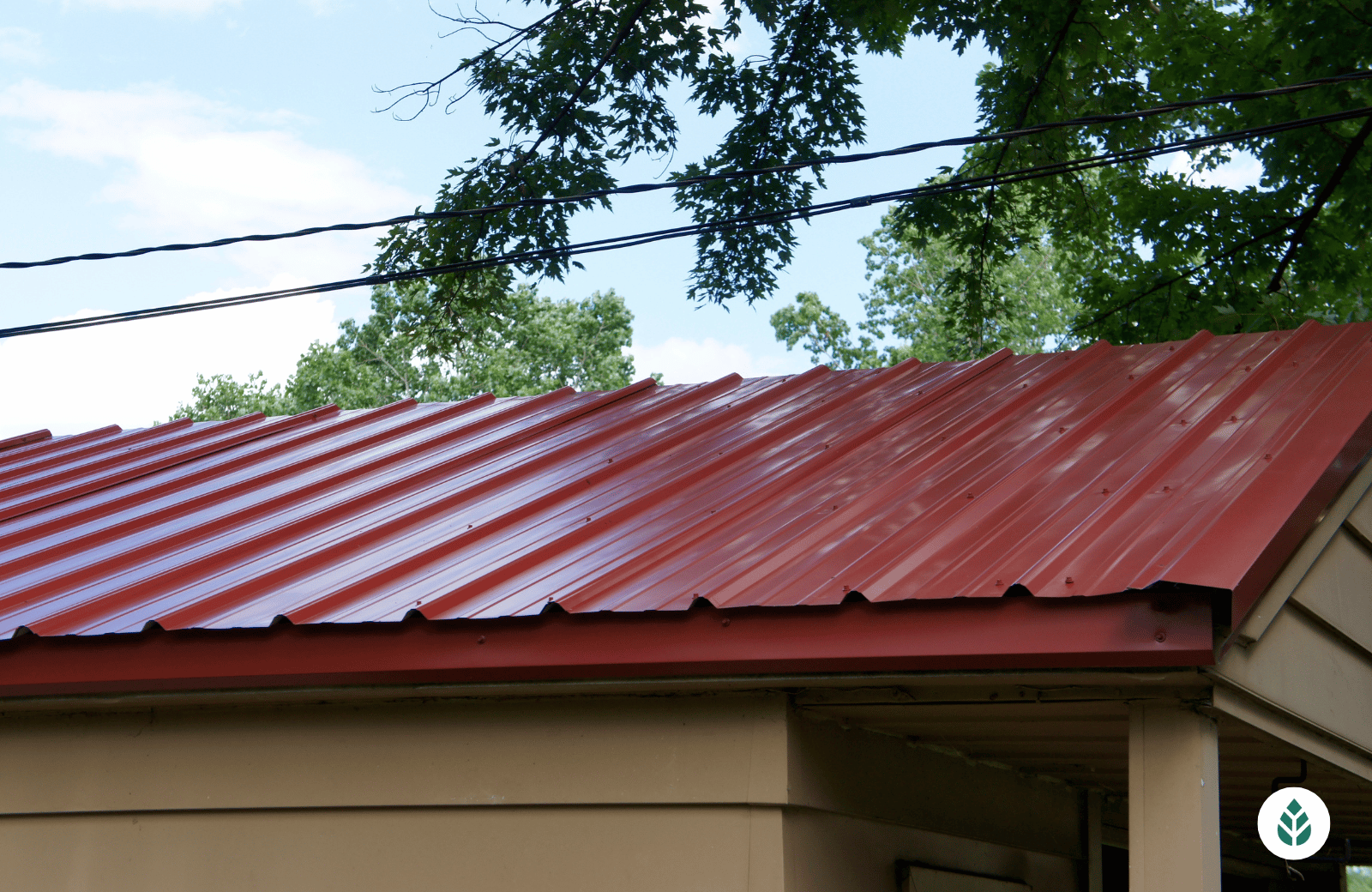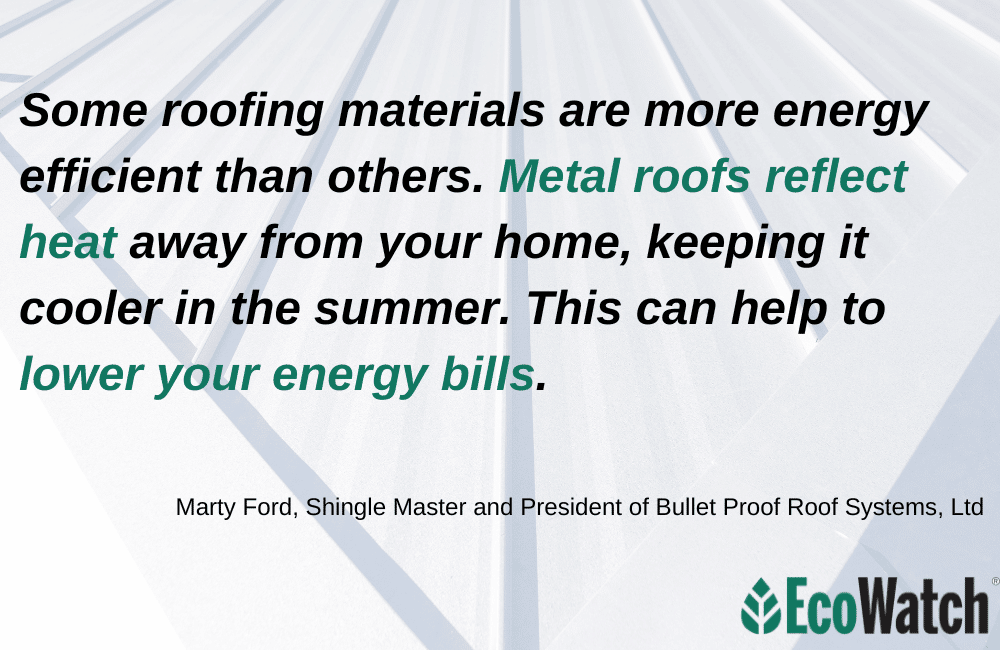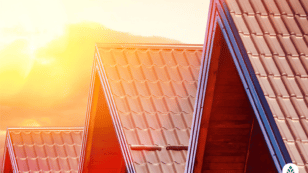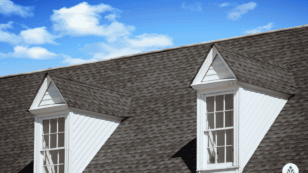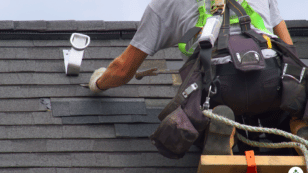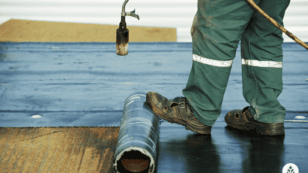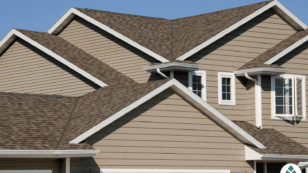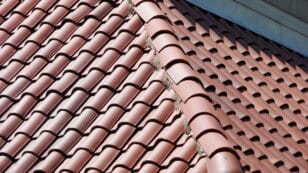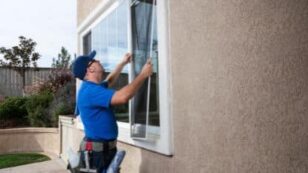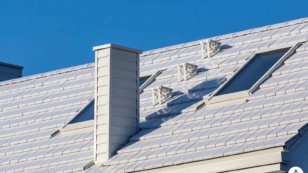
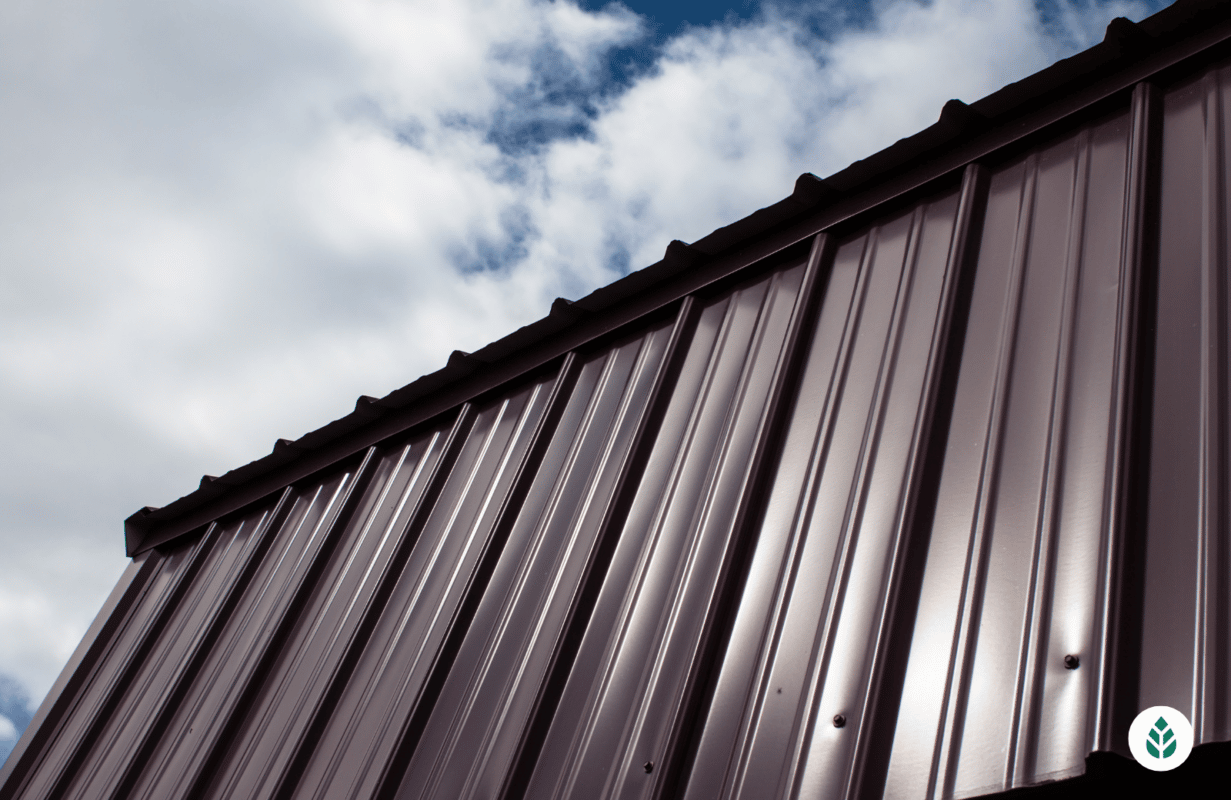
Tin Roof Cost (Homeowners Guide 2024)
Average Tin Roof Cost: $10,000 to $30,000 (materials cost)
In this roof cost guide, we’ll discuss the cost and features of a new tin roof. Here are the basics:
- Tin roofs typically last between 40 and 70 years, similar to other types of metal roofings
- Tin roofs are energy efficient and can help lower your household energy use
- The material cost of tin roofs is between $3.50 and $15 per square foot
Each product and or company featured here has been independently selected by the writer. You can learn more about our review methodology here. If you make a purchase using the links included, we may earn commission.
What is a tin roof, exactly? You may hear the term “tin roof” to generally describe any type of metal roof. However, a real tin roof is actually a metal like aluminum or steel with a tin coating.
These days, tin roofs are not as popular as other types of metal roofing, but tin is still as durable, long-lasting and energy-efficient as many other metal roofing types.
Tin roofs may not be one of the most common types of metal roofs anymore, but it’s still a great roofing option for eco-conscious homeowners.
Cost of Installing a Tin Roof
The cost of installing a tin roof is between $10,000 and $30,000. You can expect to pay between $3.50 and $15 per square foot in material costs for a tin roof. That means that tin roofs are similar in pricing to aluminum and steel roofing.
Keep in mind that this price range is just a national average for a 1,700-square-foot roof. The quality of the tin material you choose, as well as the slope, pitch, and size of your roof, will all impact your total cost. The cost of hiring a roofing contractor will also depend on where your home is located.
How to Calculate the Cost of Your New Tin Roof
Every roofing project is unique, but you can still calculate a general estimate of what a new tin roof will cost. Here’s a simple way to get an idea of what a tin roof installation would cost you:
$3.50 x size of your roof in square feet = Low-end cost of a tin roof
$15 x size of your roof in square feet = High-end cost of a tin roof
For example, if your roof is 1,700 square feet (the national average roof size), you would calculate the following:
$3.50 x 1,700 = $5,950
$15 x 1,700 = $25,500
Remember that this equation is just a simple estimate and does not include labor costs or individualized costs like your roof’s features, your contractor’s travel time, or roof removal and disposal costs.
To get the most accurate estimate, you should get in touch with a roofing professional. Select one of our top providers below to receive a free, no-obligation quote.

Power Home

Average cost
Pros
- Positive industry reputation
- Lifetime or lengthy warranty
- 10+ years of experience
- Positive customer reviews
- Uses eco-friendly materials
- Well-trained, certified installers
- Variety of roofing styles available
Cons
- Limited variety of roofing materials
- Short or nonexistent warranty
- No financing information available
- Expensive
- Little information available on company website

Erie Home
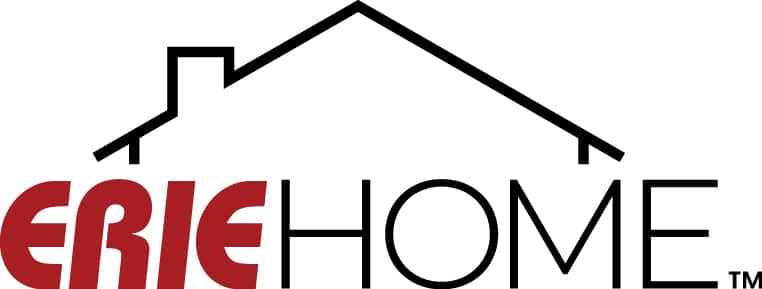
Zero Down - 18 months same as cash with minimum monthly payment
Average cost
Pros
- Lifetime or lengthy warranty
- Widespread availability
- 10+ years of experience
- Positive customer reviews
- Uses eco-friendly materials
- Financing options available
- Well-trained, certified installers
- Uses durable materials meant to last
- Variety of roofing styles available
Cons
- Limited variety of roofing materials
- Expensive

Aspen Contracting

Average cost
Pros
- Positive industry reputation
- Lifetime or lengthy warranty
- Widespread availability
- 10+ years of experience
- Positive customer reviews
- Financing options available
Cons
- Little information available on company website
Factors That Go Into Tin Roof Pricing
The final cost of your metal roof installation will depend on the specific qualities of your home. Here’s what you can expect when paying for a tin roof:
Material Pricing For Tin
Before accounting for labor and other metal roof installation costs, tin roofing material will cost between $3.50 and $15 per square foot.
Why such a wide cost range? The material prices of your tin roof will depend on which metal (or metals) serves as the core of your roof before the tin coating is added. Tin roofs also aren’t that common, so you may have to shop around to find a roofing company that offers them.
Basic Labor Cost and Time to Complete Tin Roof Installation
It typically takes one to three days to install tin or another type of metal roofing on a single-family home. The larger and more complex your roof is, the more time it will take for your roofing contractors to finish the installation.
That being said, many metal roofs can actually be installed over your existing roof, which reduces your installation time and labor costs.
The national average labor cost to hire a roofing contractor is $75 an hour. However, this number can vary dramatically depending on where you live.
According to our market research, the average labor cost for a tin roof installation will fall between $3,000 and $5,000.
Removing Your Current Roof and Dump Fees
If your old roof needs to be removed during your new roof installation, you may have to pay additional labor and disposal costs. Fortunately, tin, like other metal roofs, can often be installed directly over your existing roof. This can dramatically reduce waste, labor costs, and removal fees.
If you do have to remove your old roof, talk with your roofing company about who will be responsible for disposing of the old roofing materials. Many roofing companies will handle the roofing disposal for you. If not, it typically costs between $30 and $50 to drop off a truckload of roofing waste at your local solid waste management center.
Most roofing materials, including metal, wood, and even asphalt roofing, can be recycled. Call your recycling center or solid waste management center to discuss recycling options and arrange a pick-up or drop-off. In general, metal roofs are easier to recycle than asphalt shingle roofs.
Size and Complexity of Your Roof
Of course, considering roofing materials are priced by the square foot, you’ll pay more for your project if you have a larger roof.
However, roofing details like skylight windows, air vents, chimneys, or chimney caps make your roofing project more complex and therefore more expensive. Roofs with a steep pitch and lots of angles, valleys, or facets will also cost more. This is because your roofer will have to use more safety equipment and advanced installation techniques to install your roof.
Every roof and roofing project is unique, so you’ll want to speak with a roofing professional to get a quote. Select one of our recommended providers below to get a free, no-obligation estimate.
Pros and Cons of Installing Tin Roofs
Like other types of metal roofs, tin roofs are long-lasting and energy-efficient. However, tin roofs have disadvantages as well. Here’s what to consider when deciding if a tin roof is a good fit for your home:
Pros of Tin Roofs
-
- Durable: Tin roofs are wind, rain, hail, pest, and fire resistant, so you don’t have to worry about denting. They also require less maintenance and fewer repairs than asphalt shingles.
- Long-lasting: Metal roofs, including tin roofs, have a lifespan of 40–70 years. That’s far longer than the 20-year lifespan of asphalt roofs.
- Energy efficiency: Tin roofs reflect sunlight, rather than absorbing it and trapping heat in your home. This means that your home’s temperature will be naturally regulated and you will use less energy.
- Recyclability: Tin roofs are 100% recyclable. Many metal roofs are made of recycled materials, so make sure to request recycled materials for your new roof.
Cons of Tin Roofs
- Uncommon: Tin roofs have fallen out of favor as asphalt and other types of metal roofs gain popularity. It may be difficult to find a roofer that installs tin roofs, but there is a great selection of other metal roofing materials out there as well.
- Style: Many homeowners don’t like the look of metal roofs because they look “industrial” or, in the case of tin roofs, like an old shed or farmhouse. However, there are plenty of styles of tin roofs that are more stylish, so talk to your roofing contractor about your options. Painted metal roofing is also a good option if you want to upgrade the style of your metal roof.
- Noise: Tin roofs have a bad reputation for amplifying the sound of rain or hail. However, with proper installation, an insulated ceiling, and underlayment, you can greatly reduce these undesirable sounds.
Still unsure about what type of roof you want? The best roofing companies and contractors can help you select the best type of roof to meet your needs.
Lifetime and Durability of Tin Roofs
Tin roofs will last you between 40 and 70 years. Tin roofs and other metal roofs are low maintenance and surpass asphalt roofs in terms of durability and longevity.
Because metal roofs are so durable, they are ideal for any climate, including locations that experience extreme heat or cold, rain, snow or hail.
Are Tin Roofs Environmentally friendly?
All things considered, tin roofs are very environmentally friendly. Tin roofs are 100% recyclable and many metal roofs are made of recycled materials. Choosing recycled metals for your roof is a more environmentally friendly choice, as it diverts landfill waste and mitigates the environmental damage from mining new metals.
But that’s just the start. Metal roofs can improve the energy efficiency of your home as well. Metal roofs like tin can reflect sunlight and keep the temperature of your home stable. Asphalt roofs, on the other hand, tend to absorb heat, increasing the temperature of your home.
Here’s what Marty Ford, President of Bullet Proof Roof Systems, says: “Some roofing materials are more energy efficient than others. Metal roofs reflect heat away from your home, keeping it cooler in the summer. This can help lower your energy bills.”
To save the most on energy costs with your tin roof, choose a roof style that is factory coated with light-colored paint.1
If you want an even more environmentally friendly roof, you can also install solar panels on top of your home. Metal roofs are a great match for solar panels because they can withstand the weight of a solar panel system, and improve the efficiency of your home, which in turn reduces the amount of energy you need your panels to generate.
If you’re ready to talk with a roofing professional, select one of our top roofing companies below to get a free, individualized quote.
Financing Your New Tin Roof
New roofs aren’t cheap. Many homeowners cannot afford to pay the full cost of a new roof upfront, especially if they are getting a roof replacement due to unexpected damage to their old roof.
Thankfully, there are plenty of financing options for homeowners to pay off their roof without breaking the bank. Here are some of the most popular options:
- Finance through your roofing company: Most roofing companies have connections with banks and third-party lenders to help you find the best loans and financing options. Talk to your roofing contractor about your financing options before your roofing project starts.
- Take out a home equity loan: A home equity loan lets you use your home as collateral to secure a loan with a low interest rate. This is a good option for homeowners who have built-up equity in their home.2
- Take out a home improvement loan: If you do not have that much built-up equity in your home yet, you can still take out a home improvement loan for your roofing project. The interest rate of your loan will depend on your credit score and income level.
- Note: Low- and moderate-income households may be eligible for an FHA Title 1 loan. The FHA (Federal Housing Administration) helps homeowners secure fair loans by insuring banks and other lenders against losses.3
- File an insurance or home warranty claim: If you need a roof replacement due to an unavoidable accident or severe weather event, your insurance may cover the cost of a new roof. If your roof has gotten old but the replacement is not covered by your insurance company, your home warranty may still pay for your roof. Check and see what your home warranty plan covers — every plan is different.
The ROI of your Tin roof
A new roof can increase the value of your home. In 2022, homeowners can realize a 55% return on investment when installing a new metal roof.4
Although metal roofs are usually more expensive than asphalt shingles, you have to replace asphalt roofs at least twice as often as metal. This means that metal like tin is typically a better investment than asphalt.
Costs of Maintenance and Repairs for Tin Roofs
The most common repairs metal roofing systems require are fixing leaks, corrosion and discoloration which, on average, will run you between $550 and $1,350 to have a roofing contractor fix. Metal roofs also expand and contract with temperature fluctuations, which can cause the fasteners holding the metal roofing panels together to come loose. This roofing repair will cost you between $150 and $650 to complete.
The best way to avoid costly repairs on your metal roof is to have a roofer complete an inspection each year.
Roof Painting Prices for Tin Roofs
The best way to increase the energy efficiency of your tin roof is to paint it. Of course, some homeowners also paint their roof for aesthetic reasons. If your tin roof is getting older and starts to show discoloration or other signs of wear, painting can be a cheaper alternative to a complete replacement.
The total price of painting your tin roof is between $1,000 and $3,000, far less than the average cost of a new tin roof, which is between $10,000 and $30,000.
You can watch this video to learn more about repainting a tin roof:
Costs of Cleaning your Tin Roof
Cleaning your roof annually keeps your roof looking new. Tin roofs are very durable, so you can clean them with any of the traditional methods, including low-pressure power washing, high-pressure power washing, chemical washing and soft washing. The average cost of hiring a professional to clean your roof is $400, but this will vary depending on your roof size and material.
If you feel comfortable standing on a ladder and getting on your roof, it is possible to DIY your tin roof cleaning, but only do this if you feel completely comfortable.
The slick surface of metal roofs can also lead to significant debris build-up in your gutters, so you might also consider installing gutter guards for your metal roof.
If you’re ready to start your roofing project, select one of our preferred roofing companies below to get started with a free, personalized estimate.
Are Tin Roofs Worth the Cost?
As we mentioned previously, the average cost of a new tin roof is between $10,000 and $30,000. So, is the cost worth it?
In most cases, yes. Metal roofs, including tin, last far longer, require less maintenance, and are more energy-efficient than standard asphalt shingle roofs. You may pay a little more upfront, but metal roofs are a great investment in the long run.
FAQ: Tin roof cost
Although tin roofs are not that popular, they’re still a good investment like any other metal roof. Metal roofs have an excellent return on investment and a new roof can increase the resale value of your home.
Metal roofs like tin are great for solar panels because they can easily support the weight of a solar panel system. If you’re installing a new roof, you should also consider installing solar panels at the same time.
On average, tin roofing costs between $3.50 and $15 per square foot. This is a similar price point to galvanized steel, stainless steel, and aluminum roofing and is cheaper than high-end materials like copper and zinc roofing.

 233k
233k  41k
41k  Subscribe
Subscribe 
